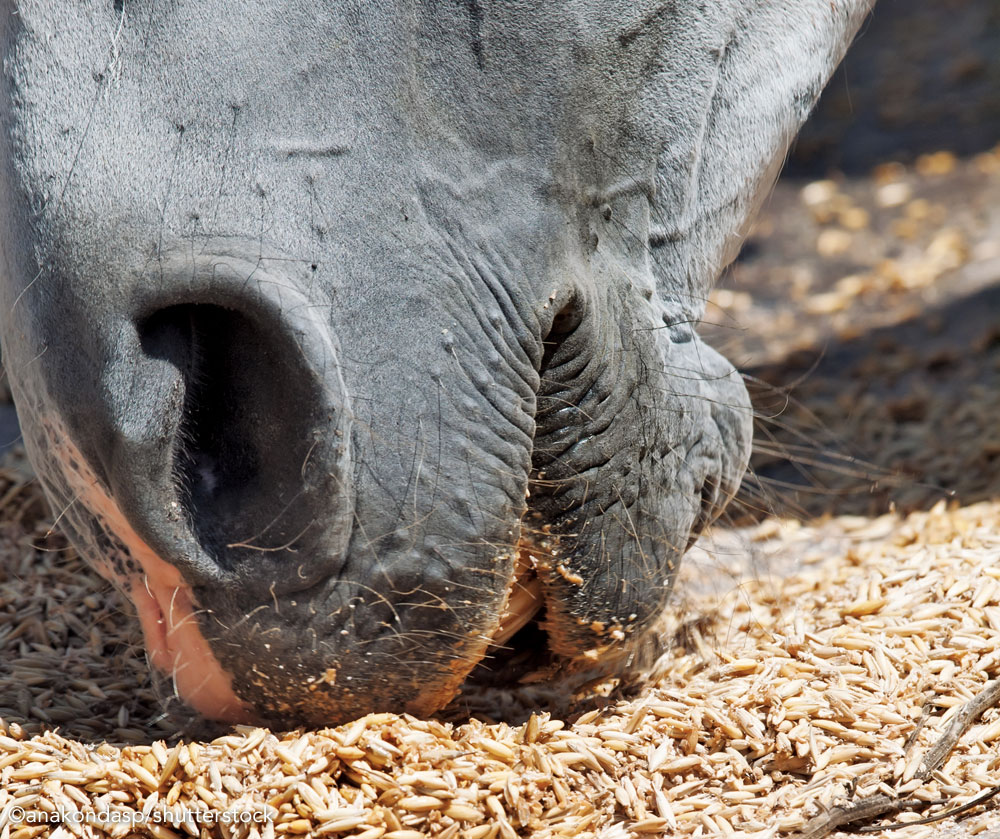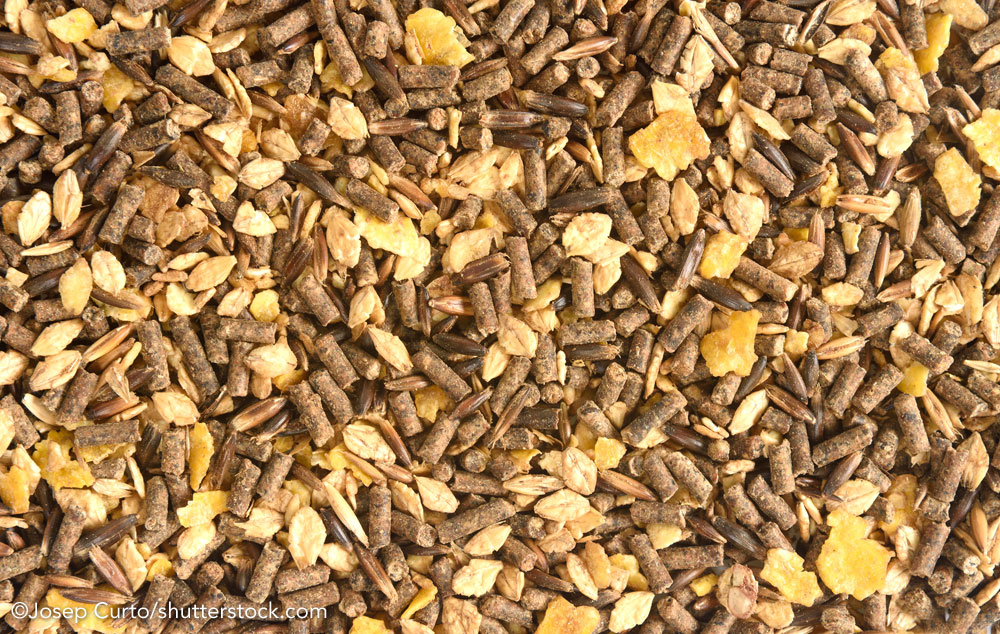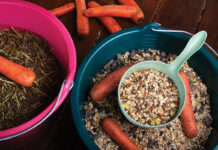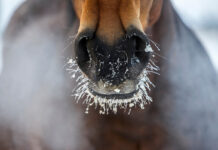When you wander through a feed store, there are many brands of equine feed, and each one has many specialized feed formulations. But what does your horse need? Here’s how to read the feed tags and zero in on what matters most.
How Much do I Need to Feed?

If your horse is used for light pleasure riding or moderate exercise, forage (hay or pasture) should comprise most of his diet. Horses that don’t have full-time access to pasture grazing are usually fed hay at least twice a day. Depending on the type, quality and amount of hay fed, additional calories may be required to keep a horse in good weight.
In some cases, a concentrate is simply fed to all horses in the barn as part of the routine care and feeding program.
To get the full nutritional benefit from the concentrate you are feeding, however, you need to feed enough of it. “A handful” will not contain the nutrients the feed is designed to provide. Read the feed tag on your particular bag and find out how much you need to feed.
For example, the tag may specify that a 1,200-pound horse in moderate work be fed 8 pounds per day. “A scoop” can mean anything, so bring out the scale to weigh your scoop and determine how many scoops per day your horse needs.
You’ll want to divide that amount of feed into several smaller meals to be easier for his digestive system to handle. If the concentrate is mostly grain (or contains molasses), don’t feed more than 0.5 percent of body weight in a single meal (i.e. 5 pounds for a 1,000-pound horse).
The sugars and starches contained in large amounts of grain and molasses will overwhelm the ability of the small intestine to break them down. If this happens, they pass undigested into the large intestine, where they’re fermented by bacteria. Bacteria are OK when all they’re breaking down is fiber, but sugars and starches can cause problematic toxins to form that may cause gas colic or laminitis.
Right Horse Feed: How Much Starch?
If your horse has metabolic disease, insulin resistance, or is generally sensitive to high-starch grains like corn or high-sugar feeds containing molasses, you’ll want to find a concentrate that is mainly fat and fiber instead. These are made with a high-fiber base, such as beet pulp. Beet pulp is a highly digestible fiber that provides a lot of calories without the starch and sugar.
Many lower-starch feeds are being marketed these days as horse owners learn the dangers of a “high carb” diet. However, horses are not the same as people.
Carbohydrates can be divided into fiber, the structural material in plants that horses need and break down in their hindgut, and non-structural carbohydrates (NSCs), meaning starch and sugar. Low-NSC feed is what is usually meant by a “low-carb” horse feed.
Right Horse Feed: How Much Fat?
If you have a hard keeper that is sensitive to starch, you’ll want to make up the calories with fat. Horses can tolerate a fairly high amount of fat in their feed, as long as they are gradually accustomed to it over a period of weeks.
Fat of all types absorbs easily during digestion, and with acclimation, your horse will be able to use it as an energy source. When picking a fat source, consider that some are high in omega 6 fatty acids, and others contain omega 3 fatty acids. Although the exact ratio horses need is not definitively known, it’s good to have a balance of both types for ideal exercise fuel and recovery.
A high-fat feed can be 8, 10 or 12 percent, or even higher. The tag will have a “crude fat” number you can use to judge.
Right Horse Feed: How Much Protein?
Another important nutrient on the tag is protein content, listed as “crude protein.” This percentage alone doesn’t give you a full picture, as there are both high- and low-quality protein sources.
Although protein from animal sources are “complete” (meaning they contain all 21 amino acids), these are not usually used in horse feed due to higher cost and lower palatability. Protein from plant sources are generally incomplete and have differing amino acid profiles.
Horses cannot produce all 21 of the amino acids in their own body. Ten must be consumed in the feed in order to build strong, healthy muscles. These are known as the “essential” amino acids. The three essential amino acids most important to horses are, in order, lysine, methionine and threonine. Small amounts of these exist in hay and pasture grass, and higher amounts are found in feed additives like flax meal and brewer’s yeast.
If a horse is getting enough of these three essential amino acids, he should also be getting enough of the other seven. Check for these amino acids on the label (lysine, in particular, is often provided) to get a more complete picture of protein quality.
The average adult horse in light work only needs about 10 percent protein in his diet. Mid-maturity grass hay contains 13 to 17 percent protein, and even a very mature (stemmy) grass hay contains 10 percent protein. Legume hays such as alfalfa are even higher, up to 18 or 20 percent protein.
This should give you peace of mind that you need not feed a 14 or 16 percent protein concentrate to your horse; these feeds are great for lactating mares and young horses that are at their most rapid stages of growth, but in general you can safely stick to a 12 percent feed for your mature riding horse.
Armed with your new feed tag knowledge, you’ll be ready to head to the feed store with confidence and select the concentrate that is right for your horse.

Feed Tag Glossary
Here’s how to sort out the terminology and find what you’re looking for at the feed store.
Concentrate: This is any bagged feed containing concentrated calories. Concentrates can be in the form of primarily mixed grains or fat and fiber.
Straight grains: Buying a bag of pure oats (or barley, or corn) is not a good idea to supplement your horse’s calorie demands. Pure grains are not balanced for calcium, protein or starch content, and can create nutrient deficiencies or starch overload.
Sweet feed/textured feed: These are grain mixes combined with molasses and vitamin-mineral pellets. (Sometimes additional fiber, fat or yeast is added.) These are a good choice for picky eaters, as the molasses makes them highly palatable. They tend to mold in hot & humid conditions or freeze in the winter if stored outside of climate-controlled rooms, however.
Pelleted Feed: The pelleting process finely grinds grain and other ingredients, then steam-heats and presses them through a pelleting form. They are low in dust and more resistant to molding and freezing, and can’t be sorted by a picky eater. The fine grinding makes ingredients more digestible, and they can be soaked if necessary. Some contain higher levels of fat and fiber, but most are a grain base with added protein, vitamins and minerals.
Extruded feed: Extrusion creates the “kibble” shape often seen in pet food. Like pelleting, grains and vitamin-mineral mix are treated with high temperatures, but unlike pelleting, pressure is used to make the final product less dense. Starches from grains are most digestible when formulated using extrusion, which is good for horses prone to gas colic or diarrhea. Since the particles are larger, they slow feed intake quite a bit relative to pellets, which is good for horses with a history of choke.
Complete feed: A complete feed is not a concentrate. It contains high levels of fiber as well as all required nutrients, and can be substituted for 100 percent of the horse’s diet in the case of a hay shortage.
Senior feed: Senior feeds are complete feeds designed with the older horse’s nutrient requirements in mind. Seniors with poor teeth or no teeth may depend entirely on a diet of soaked senior feed.
Ration balancer: Ration balancers contain only vitamins, minerals and protein. These are a good choice for easy keepers maintaining their weight on forage (hay or pasture) alone. They are designed to be fed in very small amounts: only 1-2 pounds per day.
This article originally appeared in the February 2019 issue of Horse Illustrated magazine. Click here to subscribe!





